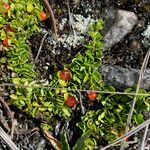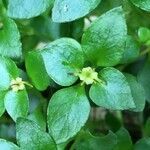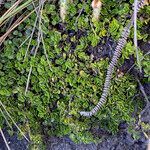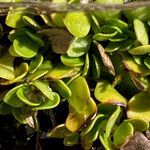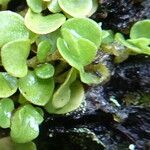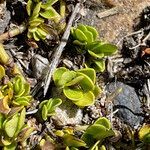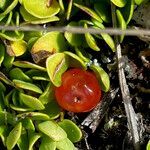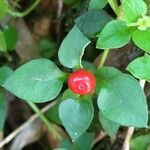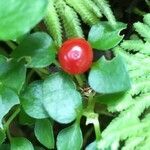Herbs, epiphytic or creeping, occasionally to 1.3 m tall, the branches short, glabrous or webby pubescent (mouldy?), often drying deep purplish red. Leaves ovate rotund, to 1.3 cm long, to 1.25 cm wide, slightly inequilateral, widely deltoid at the apex, ultimately retuse or minutely apiculate, basally subcordate to trun-cate, the base deltoid as it passes into the petiole, the costa plane or evanescent above (then often pubescent), plane to prominulous beneath, the lateral veins 2-5, often evanescent, the 2 basal veins together with the costa appearing flabellate, widely arcuate, carnose but drying thin, glabrous or pubescent, the hairs thick, falcate, appressed, often only the hair bases persistent and the surface then silvery lepidote, the margin delicately marginate; petioles 0.9 cm long, to 0.3 cm wide, glabrous, often grooved above; stipules interpetiolar, triangular, to 1 mm long, to 1 mm wide. Flowers solitary; hypanthium oblong, ca. 1 mm long, with a few scattered hairs, the calycine cup short and without lobes; corolla yellow green or pale yellow, the tube widely funnel shaped, inflated, ca. 0.8 mm long, glabrous, petaloid; stamens 4, the anthers rotund, ca. 0.3 mm in diam., the filaments ca. 1.5 mm long, inserted at the base of the corolla tube; stigmas 2, reflexed, subulate, ca. 1 mm long, longer than the style, the ovule 1, large, pendent. Fruits sessile, scarlet at maturity, oblong, to 2.5 mm long, to 2 mm wide, glabrous, delicately reticulate and with a few delicate longitudinal lines, the raphides abundant.
More
Creeping herbs; stems angled, glabrescent. Petiole slender, 2-4 mm, glabrescent; leaf blade drying papery and often pale abaxially, ovate or ovate-triangular, 0.3-1 × 0.2-0.8 cm, glabrescent, generally smooth abaxially, base obtuse to shallowly cordate, apex acute to obtuse; secondary veins 2 or 3 pairs; stipules ovate-triangular, 0.5-1 mm, glabrescent, apex acute and often glandular. Flowers sessile or subsessile. Calyx glabrous; ovary portion ellipsoid, ca. 1 mm; limb reduced. Corolla white to pale green, glabrous; tube 0.5-1 mm; lobes ca. 1 mm. Drupes red, subglobose, 3-5 mm in diam.; pyrenes 2.
A herb which forms mats. It keeps growing from year to year. It lies along the ground and spreads 10-30 cm wide. The stems are slender and much branched. They are about 10 cm long. They form roots at the nodes. The leaves are 0.3-0.5 cm long by 0.3-0.45 cm wide. They are oval or rounded. The stalks are 0.4 cm long. The flowers are 0.2 cm long and like tubes. They have spreading lobes. They are yellowish-green. They occur singly at the ends of branches. The fruit are small and yellow or orange-red.
